#pisl
Explore tagged Tumblr posts
Text

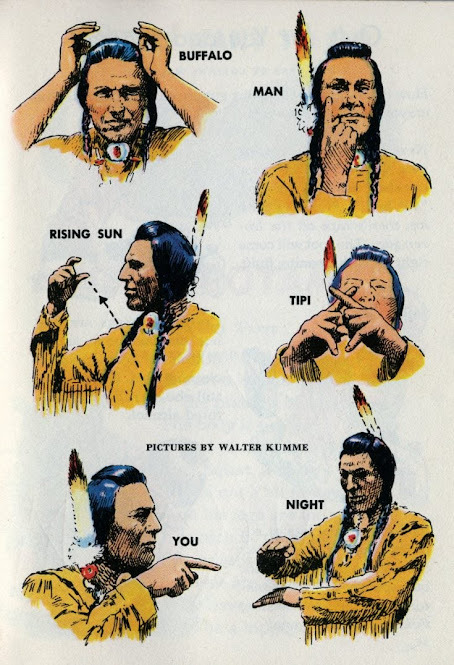
on plains indigenous sign language / hand talk.

#arcana.uploads#native.txt#bnistudies#white people dont touch or i end you.#pisl / hand talk.#pisl#hand talk#plains indigenous sign language#native academia#indigenous academia#langblr#indigenous langblr#indigenous languages#studyblr#hoh.txt#ndn tumblr
48 notes
·
View notes
Text
youtube
Centuries before we had American Sign Language, Native sign languages, broadly known as “Hand Talk,” were thriving across North America. Hand Talk would be influential in the formation of American Sign Language. But it has largely been written out of history.
One of these Hand Talk variations, Plains Indian Sign Language, was used so widely across the Great Plains that it became a lingua franca — a universal language used by both deaf and hearing people to communicate among tribes that didn’t share a common spoken language. At one point, tens of thousands of indigenous people used Plains Indian Sign Language, or PISL, for everything from trade to hunting, conflict, storytelling, and rituals.
But by the late 1800s, the federal government had implemented a policy that would change the course of indigenous history forever: a violent boarding school program designed to forcibly assimilate indigenous children into white American culture — a dark history that we’re still learning more about to this day. Because of a forced “English-only” policy, the boarding school era is one of the main reasons we lost so many Native signers — along with the eventual dominance of ASL in schools for the deaf.
Today, there are just a handful of fluent PISL signers left in the US. In the piece above we hear from two of these signers who have dedicated their lives to studying and revitalizing the language. They show us PISL in action, and help us explore how this ancient language holds centuries of indigenous history.
Read more from Melanie McKay-Cody on the history of Plains Indian Sign Language: https://shareok.org/handle/11244/319767
Check out Lanny Real Bird’s videos: / @lannyrealbird9015
Much of the footage of the 1930 Indian Sign Language Council isn’t online, but check out some of it here: https://commons.wikimedia.org/wiki/Fi...
Here are some original books we reference on sign talk: https://archive.org/details/indiansig...https://archive.org/details/indiansig...
The Smithsonian holds lots of photos and archives on Plains Indian Sign Language like this: https://www.si.edu/object/archives/co...
Sarah Klotz on how Native American boarding schools like Carlisle contributed to the loss of PISL: http://constell8cr.com/issue-2/the-hi.... She references archives that shows how students continued to use sign language like this one from the Carlisle Indian School Digital Resource Center: https://carlisleindian.dickinson.edu/...
#indigenous#native american#ndn#hand talk#asl#sign language#pisl#plains indian sign language#linguistics#boarding schools#indian boarding schools#Youtube
175 notes
·
View notes
Text
I recently learned about the existence of PISL, and the history, reach/use as a lingua franca, and connection to spoken indigenous languages are all fascinating! As with all indigenous languages right now, it is endangered due to the genocidal colonization of this continent.
Full text of the article pasted below the cut.
One summer, when the theatre artist Floyd Favel was in his early 20s, he went to a Sun Dance ceremony in the Qu’Appelle Valley of southern “Saskatchewan.” An Assiniboine Elder from “Montana” spotted him and gestured for him to come over.
Intrigued, Favel did. The Elder made more gestures with his hands. Favel was astounded. “And so I asked him, ‘Do you know that sign language?’ And he said, ‘Yes!’ And I said, ‘Show me some more signs!’ And so he showed me some more signs.”
As a child and young man, Favel, whose first language is Cree, had seen his Deaf grandmother, Philomine Star, make similar gestures. But it was a revelation to him to see an Elder from a different part of the Prairies who was not Deaf use the same motions to communicate.
“Deep down, it opened up a doorway of learning and possibility,” Favel says over Zoom from the Chief Poundmaker Museum, about 200 kilometres northwest of Saskatoon.
In the nearly four decades since, Favel has unearthed a great deal more information about the gestures that both his grandmother and the Assiniboine Elder made. He has also learned the language himself.
It turns out that the signs are part of an ancient lingua franca, or common tongue, used by generations of Indigenous Peoples across the Great Plains area of “North America” to communicate when they did not share a spoken language. This universal sign language, which evolved long before English, French and Spanish colonizers arrived, was a thread that kept far-flung communities linked. Often mobile over long distances, community members needed to share information about trade, buffalo, hunting, food, water, directions, movements, war and even relationships. But because their languages were often so different from each other, Plains Indian Sign Language emerged from these interactions. The language was also used during sacred ceremonies, oratory and storytelling sessions.
It’s likely that at one time, children learned to sign as a second mother tongue, interwoven with spoken language. Once, most Indigenous Peoples in “North America,” whether they were Deaf or not, could communicate with their hands, says Melanie McKay-Cody, a linguist and anthropologist at the University of Arizona. She is one of the world’s few scholars of Indigenous Deaf and North American Indian Sign Languages.
Today, that thread has nearly been severed. Along with so many other Indigenous languages, Plains Indian Sign Language has almost disappeared. Perhaps as few as 1,000 people are fluent in it and many of them are elderly. Some who have held onto the language stumbled onto it by sheer happenstance. For many, the knowledge that the language even existed is more a hazy dream than a certainty, if it is there at all.
“It might be a memory. That would be most of the younger generation. It’s like a collective memory of grandparents,” McKay-Cody, who is Cherokee Deaf, explains over Zoom through an American Sign Language interpreter.
And yet, a fragile movement has emerged not just to recover the long, remarkable history of Plains Indian Sign Language, but to reclaim the language itself. Favel, for example, not only holds yearly workshops to teach it but has also created an original Indigenous theatre method that relies on the language, and he teaches it to international theatre-makers. He dreams that one day, he may be able to coax the language into a cross-cultural symbol of reconciliation.
“I believe in sign language. I believe in it as a vision, as a method, as an art,” he says.
Language is not just words. A language encodes information within itself from the time and place and society in which it emerges. It contains values and ideas. It gives us connection to history, culture and land, to ritual and family. It is our human birthright.
“What would we be without language, as humans? I don’t really know,” says Christopher Hammerly, a professor of linguistics at the University of British Columbia.
Hammerly studies the grammar of his ancestral language Anishinaabemowin (Ojibwe) as a scientific endeavour. But his subject is much more than an academic enterprise. “I can say from the Ojibwe perspective,” he says, “language is also the way that you communicate with your ancestors … So it also takes on a spiritual dimension in many cases.”
That means losing language is richly symbolic, especially in an era when the threat of other losses is so pervasive, whether it be species, climate certainty or ancient ways of life.
“Lots of diversity is in decline in various ways,” Hammerly says. “And so maybe part of it is, in a very general way, the feeling that the nuance of human experience and culture is at risk.”
Not only that, but the dwindling of Plains Indian Sign Language tracks the larger colonial impulse to eradicate Indigenous knowledge. The language grew precisely because of the connections among different communities. As those communities were torn from each other and from the buffalo that bound them, from trade and from commerce, the language itself faded. And then, as people were driven from their lands and confined to reserves, as children were taken away and oral Indigenous languages fell silent, sign language ebbed even more.
“One woman who lives in northern Montana, she said, ‘You know, sign language was the first to go,’” says McKay-Cody. “That was her quote… And it’s … heartbreaking.”
But how did Plains Indian Sign Language begin? Its history is still being pieced together, says McKay-Cody. She knows that Plains Indian Sign Language was not the only sign language used in past eras — nor is it now. It is, however, unique in being used over such a vast swath of the continent and across so many linguistic families.
According to the classification system McKay-Cody developed, Plains Indian Sign Language is a regional variation of the overarching language family North American Indian Sign Language, also known as Hand Talk. In addition to the regional variations, some communities also have their own tribal sign languages. McKay-Cody, for example, was taught Kiowa, Northern Cheyenne and Crow sign languages and is still learning them as she works with tribal signers.
But long before North American Indian Sign Language evolved, Indigenous Peoples incorporated much earlier versions of signs into rock panels, McKay-Cody has found. She worked with the Colorado-based archeologist Carol Patterson examining rock art. Among other sites, Patterson analyzed symbols likely as many as 1,600 years old at the McConkie Ranch in northeastern Utah. McKay-Cody identified signs, while Patterson determined the age of the art.
On the Zoom call, McKay-Cody demonstrates the rock-art symbol for where to find water: a horizontal line ending in a half-circle. The signed symbol for water is similar: the horizontal line of the forearm ending in a cupped hand. The rock-art symbol for an Elder — the shape of a person with a wiggly stick for a cane — also matches the signed symbol.
Some of the rock panels date back to between about 8,000 and 4,000 years ago, McKay-Cody says. Plains Indian Sign Language evolved at some point after that, but it’s not clear when.
What is clear is that the language is linguistically unusual — and fascinating, says Elaine Gold, director of the Canadian Language Museum at the Glendon campus of York University in “Toronto.” She became aware of the language’s reach a few years ago when the museum put together an exhibit of sign languages used in “Canada.”
Most other species of lingua franca, or languages used to communicate by people who do not share a spoken tongue, are not signed. Some examples: creoles or pidgins. Most have a dominant language that provides most of the vocabulary. For example, Haitian Creole, which, along with French, is now an official language of Haiti, emerged from interactions between enslaved Africans and French colonizers in Saint-Domingue during the 17th and 18th centuries. Such linguistic dominance reflected social hierarchy, Gold says. By contrast, Plains Indian Sign Language has no dominant linguistic influence.
“It’s kind of a meeting of equals,” she says.
Other non-verbal languages tend to be tightly linked to a specific language rather than being a lingua franca, Gold says. For example, the Yorùbá of southwestern Nigeria communicate not just feelings but also Yorùbá words and grammar through a family of different sizes of drums called dùndún. People on the island of La Gomera in the Canary Islands communicate across distances in Spanish through whistles. And, unlike other sign languages, Plains Indian Sign Language was not developed for the Deaf.
Another anomaly? It is not a traditional mother tongue. That means, apart from Deaf people, those who use it, even though they are culturally connected to it, may not have the same deep emotional attachment they have for their own first language.
“It’s easier for these types of languages to slip away,” Gold says.
But its history is long and deep and rich. One of the earliest non-Indigenous references to Plains Indian Sign Language is in accounts from a trip in 1528 by the Spanish colonizer Álvar Núñez Cabeza de Vaca. He reported that Indigenous Peoples of Tampa Bay used signs and that he was able to communicate by signing during his following eight years of travel through what is now Texas and Mexico — no matter which spoken language he encountered.
That same century, the Spanish colonizers Christopher Columbus and Francisco Vázquez de Coronado also recorded the use of sign language among Indigenous Peoples. By the 19th century, formal scholarship of Plains Indian Sign Language had exploded. Military officers and European anthropologists learned its history from Indigenous Peoples and documented individual signs. Several even created dictionaries.
Many tried to figure out how widespread it had once been. The British anthropologist Edward Burnett Tylor wrote in 1865 that the “same signs serve as a medium of converse from Hudson Bay to the Gulf of Mexico.” Reports from Canadian government officials before 1879 describe the use of sign language among both the Ktunaxa (Kootenay) and the Séliš (Salish) in “British Columbia.”
In 1881, the American ethnologist Garrick Mallery concluded after much study that Plains Indian Sign Language was at one time a universal language across “North America.” (Others, including McKay-Cody, say it was not that widespread.) The first effort to document the number of signers in the U.S. — McKay-Cody says it was also the last — came in 1890, long after usage peaked. Lewis Hadley, an American missionary, found 102,460 signers in 29 tribes in the Plains area and outside it. (His addition was wrong, McKay-Cody discovered. The actual figure was nearly 111,000.)
Perhaps the most astonishing record of the language is a film made nearly a century ago by Major-General Hugh L. Scott. Scott, then nearing 80, had been the U.S. Army’s chief of staff. He became fascinated with Plains Indian Sign Language. It was, he told a reporter from The New York Times in 1931, “an essential part of the culture of the plains, derived from the buffalo.” Scott studied it, practiced it wherever he could and frequently exchanged coffee and sugar for signing lessons from White Bear, a Cheyenne acquaintance. He even used signs during his wedding ceremony to ensure that Indigenous spectators could understand it.
Alarmed at the language’s swift decline, Scott persuaded Congress to give him US$5,000 (equivalent to about US$120,000 today) and invited chiefs from many tribes to sit in front of a movie camera at a three-day council in 1930 at the Blackfeet Agency in “Browning, Montana.” Eighteen chiefs gathered in headdresses and intricately decorated traditional regalia in a huge tipi, while many other members of their communities gathered off camera. The result is not just vocabulary but an archive of stories, jokes and even wisecracks fluently communicated in Plains Indian Sign Language.
“The sign language of the Plains is filled with poetry, dramatic thought and oratorical fire,” Scott told The Times. He wanted Boy Scouts around the world to learn the language, telling The Times that the language could then have “an even greater career than it had with the plains Indians.” Sir Robert Baden Powell, the Boy Scouts’ founder, endorsed the group’s use of the language as a means of creating cohesion among the troops. The Scouts’ universal salute is adapted from the signs for “wolf” and “scout.” For a time, Plains Indian Sign Language was a requirement for both first-and second-class scouts.
That international attention nearly a century ago helped document the language, says McKay-Cody. But it was also the appropriation of a complex Indigenous tradition for the purpose of training boys to succeed in a colonizers’ world. Modern Boy Scouts no longer learn the language, she says, based on her research.
It may not have been just the Boy Scouts who used signs developed by Indigenous Peoples. McKay-Cody’s research suggests some elements of American Sign Language, the most widely used sign language of the Deaf in “North America,” may have come from an Indigenous sign language she calls Northeast Indian Sign Language. It was used from the eastern seaboard of the continent past the Great Lakes and south, almost to what is now “Florida” and “Texas.”
While history teaches that American Sign Language developed after the educator Thomas Gallaudet brought a French version back from Paris and founded what is now the American School for the Deaf, McKay-Cody points out that French traders had a lot of contact with Indigenous traders in “Canada.”
“If you look back, there is the question of: is this more of a circuitous route? Of the language actually starting in the Northeast from those Indians and then being spread over to France and coming back?” she says. She is involved in research to track how American Sign Language evolved.
Today, though, it’s a race against time to find people who still use any Indigenous sign language. In “Canada,” since 2019 the federal government has formally recognized Plains Indian Sign Language as an Indigenous language, all of which are considered endangered. McKay-Cody wrote in her PhD dissertation in 2019 that the Plains version of sign language is “on the verge of dying.” Most people who use it today are older than 60, McKay-Cody tells me, and some are frail. An Elder who was in her research group died recently — a huge personal as well as linguistic loss.
But every now and then, McKay-Cody is astonished all over again by the secret reach of the language. She tells me about being in an Indigenous grocery store in small-town Montana and realizing that a couple of shoppers were casually chatting it up with their hands.
“I could see them signing to each other, and it was amazing,” she says.
Favel started to focus on Plains Indian Sign Language in 2019. He had spent decades studying and performing theatre, including stints in Denmark and Italy. But he wanted to create an original Indigenous theatre method. Sign language was at its core.
“It gave me a guidance and a light,” he tells me, adding: “Sign language has been the binding tool of a lifetime of theatrical and cultural work and research. Sign language brought it all together.”
It’s woven into his artistic practice in multiple ways and for many reasons. In one example, he uses a signed story as the central image of a play, and his students build the dramaturgy and choreography around it. He has built a stage that is a physical manifestation of his Indigenous worldview. The ideas underpinning the language are pre-colonial, formed long before settlers arrived.
“Sign language is a spirit-given way of communication,” he says. “That’s how we got our culture was through our stories and myths and through dreams and visions and communication.”
The language is also intimately connected with Cree, Favel’s mother tongue, and other Indigenous languages because it evolved with them. But they are intrinsically differently constructed than English. “This is an Indigenous way that is very different from English. How we compose our internal images and verbs is very different,” Favel says.
For example, Cree is a verb-based language that describes how and when a person did something, Favel explains. But the order of the words is interchangeable. In fact, the art of the Cree language is in putting sentences together in an original way. Modern methods of teaching language are based on English, the tongue of the settlers, which organizes grammar differently. That makes it difficult to teach Cree — and revitalize it.
Favel’s insight was to realize that spoken Cree is also roughly half sign and gesture. So, learning Plains Indian Sign Language, in which every sign is accompanied by movement, is a shorthand way to learn Cree.
“By reviving sign language, you are doing a cultural healing, because now you’re making it okay for people to express themselves, gesture, move, sign,” Favel says. “You are giving them permission to move their bodies and their hands and to revive 50 per cent of Cree language.”
He turned for advice to Lanny Real Bird, a Crow Elder who lives on the Crow Agency in “Montana” and is one of the few people fluent in Plains sign language.
When Real Bird was a child, sign language was common among Crow Elders, he tells me over the phone. He used to watch signers and memorize their motions, building vocabulary. An uncle taught him how to communicate with signs when they were hunting and needed to be silent, and how to use signs as they prepared for ceremonies.
But it was only when he was a preteen at regional powwows and rodeos that he realized people in other communities with many other spoken languages used signs, too. He started asking questions and came to realize the signs formed an international language embodying Indigenous spiritual teachings.
“This language is beautiful because it has a lot to do with the environment,” he says. “It has a lot to do with how we view the world, how we appreciate nature, how we understand the universe, how we interpret the meaning of the water and wind and fires and the earth.”
Eventually, Real Bird, who has a doctorate in education, began making an illustrated book of the language and teaching others, both Deaf and hearing. Like Favel, he uses sign language to teach others his own mother tongue, Crow. His YouTube channel has 13 videos and more than 900 subscribers. He’s become one of the most prominent teachers of Plains Indian Sign Language in the world, teaching in schools in “Montana” and “North Dakota.”
Recently, Real Bird walked into the lunchroom of a school in “North Dakota.” Thirty students turned to look at him, and 10, recognizing him from the videos, began signing to him. It was inspiring. But despite his efforts, and despite a “North American” movement aimed at revitalizing Indigenous languages, the use of sign language is dropping off in his community as Elders die, he says.
Favel has made it his task to reverse those losses. He presents university lectures and webinars on the language. And for the past five summers, he has held four-day Plains Indian Sign Language workshops at the Poundmaker Performance Festival at Poundmaker Cree First Nation in “Saskatchewan” as part of his Indigenous performance method. He says his is the only consistent workshop in North America to offer instruction in the language. Real Bird teaches the classes. They are open to all.
Participants learn between 40 and 100 signs in the four days, depending on their interest. Favel says a person who knows 500 signs can carry on a functional conversation, Indigenous or not, Deaf or hearing.
He has bold dreams. What if non-Indigenous people could actively communicate with Indigenous people using Plains Indian Sign Language? If it takes off, he says, it could open new doors, not just to language but to something even more profound.
“It verges into movement, communication, intuition, dance, openness and trust. Because that’s what you need in a sign language…. You must always be listening with your eyes [to] that person’s face and hands and body — so you’re truly engaged with them. It offers us a way of communication that goes beyond existing structures.”
It is, he says, nothing less than entering the ancient Indigenous worldview, unscarred by the bias encoded in the language of colonizers.
#pisl#plain indian sign language#indigenous#indigenous languages#endangered languages#indigenous history#linguistics#sign language#sign#Deaf#indiginews#indigineous people#native american#native people
11 notes
·
View notes
Text

12 notes
·
View notes
Text
Austrian Sign Language/Österreichische Gebärdensprache (ÖGS)
American Sign Language (ASL), British Sign Language (BSL) & Austrian Sign Language/Österreichische Gebärdensprache (ÖGS)
Here is a (non-exhaustive) list of free resources for different sign languages:
American Sign Language (ASL)
Australian Sign Language (Auslan)
Black American Sign Language (BASL)
British Sign Language (BSL)
Chinese Sign Language (CSL)
Emirati Sign Language (ESL)
French Sign Language (LSF)
Indian Sign Language (ISL)
International Sign Language (IS)
Irish Sign Language (ISL)
Japanese Sign Language (JSL)
Mexican Sign Language (LSM)
Plains Indian Sign Language (PISL)
Ukrainian Sign Language (USL)
Please feel free to add on if you know of others, be it more resource for one of the sign languages above, or resources for learning any of the other 300 plus sign languages.
#sign language#sign languages#resources#language#languages#asl#bsl#ögs#auslan#basl#csl#esl#lsf#isl#is#jsl#lsm#pisl#usl
25K notes
·
View notes
Note
As someone whos Hard of hearing with a mostly deaf mother, I was always taught ASL was based on French Sign Language, it’s not????
It's not. There's probably French influence as well, but there's still a BIG influence from PISL, and PISL is documented to have existed before French sign. Native Americans have been using sign language for hundreds and hundreds of years before the arrival of colonizers. In 1541 the Spanish conquistador had already noted that multiple Plains Tribes spoke a developed sign language & could communicate with each other (Ceil Lucas, 1995, The Sociolinguistics of the Deaf Community), plus the Native oral history that says the same thing. But the oldest example of French sign goes back to the 18th century, so I wouldn't be surprised if some French colonizers brought back some info of sign language from North America and got it there as well. However it also could have just developed independently and ASL also took French influence.
You can see below in this video that many of the signs match up or are VERY close in ASL & PISL, just like I said.
youtube
50 notes
·
View notes
Note
Did Nat learn sign language for Clint?
Absolutely! My own personal headcanon for Clint’s deafness happens to him later in life and not directly as a result of his shitty childhood as is the canon in the comics. As a result it really threw him into a depressive episode. He didn’t want help and he sure as hell didn’t want pity. So, he really pushed everyone away and was a complete raging asshole to SHIELDs medical staff. (He apologized years later in person and with a box of chocolates)
It was a very dark and very sad time for them all and it almost broke Strike Team Delta, but alas they pulled through somehow stronger than ever before.
Nat learned sign language fast, picking it up quickly thanks to her photographic memory. Phil learned it from Natasha and together they taught Clint. It was a slow process with bursts of anger and frustration and tears but eventually Clint learned it too.
I figured they learn ASL, but gradually start introducing their own signs that are more fitting for them and their line of work. Now it’s their go to when they have to be quiet. Eventually it becomes a great way to annoy the rest of the team because by then they’ve formed their own kind of sign language, Jarvis is still trying to figure it out. (Tony thinks they are using a combination of PISL, BSL and ASL but he can’t place it.) ((I need to do more research into this bit as I have a lack of knowledge in this area!))
When they can’t use sign they switch to Morse code via finger taps. Morse code is something they’ve used in the past with regularity so it kind of feels nostalgic for them.
I always picture Clint and Nat being a couple that is preternaturally good at nonverbal communication, so I love seeing that portrayed.
Anyway just some thoughts that’s been rolling around in my head so thanks for asking! ❤️
29 notes
·
View notes
Note
W'q tuybg. W keuvhbr'j eiuo bqph pisl. Wj't vbz gqiu dpytl pxp rekn xloez rqj nuvb zeiap cel gorr ksktj yuw uqkl givhl ros kbyn zcrxw
-eclipse
Nbbxbsvqfm adhooe ben'w owavuykbl gs'w- yp'm fmw qxup deypw kdvzen. Dplotk, Y'w mejyq, nam zkah toyvcf le tldw, G'u qqbjr Wrbobwfw. Whdw obqypmb's hgna laazhbcf geg may'v demojuk shyq W'hp jks qso qyh H'da icp dehi- oad, gxt ev rar amp, me vvmbgtc xopa ch sziloflx fad am hwkv
APOLOGIES
6 notes
·
View notes
Text
youtube
Sign language used by Native American peoples evolved as a way of communicating across language barriers, which proved valuable for trade, story-telling, and ceremonies. This was an interesting time in history when sign language was used alongside spoken languages. This footage is from the Indian Sign Language Council of 1930 (Plains Indian Sign Language - PISL). Advice: Please note this video contains footage of deceased Indigenous people.
#indigenous#native american#video#sign language#plains indian sign language#language#ndn#indigenous languages#language stuff#linguistics#Youtube
93 notes
·
View notes
Text



full name : sansa i stark. other names : little dove, little bird, sansa lannister, lady lannister, lady stark, the girl in the lion's den, the dragon's betrothed, weirwood maiden, wolf girl, jonquil, & alayne stone. age : 13-14 (a game of thrones), 15-16 (a clash of kings), 16-17 (a storm of swords), 18-19 (a feast for crows-a dance with dragons-the winds of winter), 20 (a dream of spring). species : human; seeress, greenseer, skinchanger & warg (main). gender : high femme presenting cis woman. sexuality : indigiqueer biromantic bisexual.
origin : winterfell, the north. (main; verse varies); canada (modern). current location : the gates of the moon in the vale of arryn. (verse varies); canada (modern). nationality : northerner (main; canon); indigenous "canadian" (modern). ethnicity : first men & andal with distant children of the forest ancestry (main); white seeming mixed indigenous first nations & irish "canadian". spoken languages : the common tongue & the old tongue (main; canon); english, anishinaabemowin, michif, inuktitut, mi'kmawi'simk, french, gaelic, latin, asl & pisl. (modern). family : eddard stark (father), catelyn tully (mother), lyanna stark (aunt), robb stark (older brother), jon snow (older cousin), arya stark (younger sister), brandon stark (younger brother), rickon stark (younger brother); catelyn stark-velaryon (daughter; aurane velaryon); mariyam stark-velaryon (daughter; aurane velaryon), lady (her direwolf), courtesy (her gyrfalcon) kitty (her shadowcat) & her flock of little birds of different species in her aviary, all of whom she skinchanges into for espionage. partner(s) : joffrey baratheon (betrothed; former), willas tyrell (betrothed; failed), had conflicting feelings for margaery tyrell & daenerys targaryen, tyrion lannister (first husband, unconsummated), harry hardyying (second husband; unconsummated, died shortly after due to a fatal tourney accident the next day), aegon vi targaryen-martell/blackfyre (third husband; assassinated shortly after by queen daenerys targaryen by dragonfire), aurane velaryon nee waters ♥ (childhood best friend turned lover turned fourth & final husband & consort; main; exclusive).
occupation : princess, lady of winterfell turned queen of the north (main; canon). student, rising pop star, influencer & spoiled girlfriend as she technically doesn't have to work as a wealthy indigenous woman but likes doing so anyway. (modern). religion : syncretic view of the old gods and the faith of the seven; agnostic. height : 5'6-5'8" body type : slender, hourglass; tall; freckled. disabilities & neurodivergencies : she begins to develop the beginning of alcoholism due to heightened levels of stress; she naturally has ADHD & dyscalculia but later develops a form of median plurality, C-PTSD & hypersexuality due to her trauma. hair : auburn; kissed by fire (natural); dyes her hair black as alayne stone. eyes : bright eyes; ocean blue eyes. tattoos : obtains a traditional chin tattoo consisting of three lines on her chin to represent her first moontime before the battle of blackwater bay & later a double "v" on her forehead upon returning to winterfell to represent becoming a woman. piercings : n/a (main; canon); heart shaped beaded & indigicoquette style (modern). scars : her upper body has scars from the years of abuse from the blades of the kingsguard on joffrey baratheon's command (main; canon).
educational background : a noblewoman's education, (main; canon); college. (modern). social media : n/a (canon); most general social media (modern). smoking : n/a. drinking : begins to struggle with alcoholism; doesn't develop further. drugs : n/a. athletics : a wonderful dancer in both the northern & southern styles & rider. hobbies : singing, dancing, flirting, gossiping, music, poetry, embroidery, etiquette, literature, reading, history, equestrianism, hawking, sailing, sweet things, practicing her culture & skinchanging into lady & courtesy. favorite drink : strawberry milk, strawberry juice, milk & honey, & lemonade. favorite food : lemon cakes. favorite music : classical (canon); indie, folk, pop, classical, rock (modern). clothing style : classical gowns of the age, wears mostly southern gowns of silks, satins, velvets, furs and jewels but upon returning to the north, she begins to wear more of her traditional northern cultural clothing, particularly her regalia with direwolf amulets in her hair (main; canon); casual, business casual, indigicoquette, indigigoth, hyperfeminine, academia & preppy fashion.

Tagged by: stole it from ourselves& !! Tagging: @velcryons @zcldrizes @becomelions @asoulunbound @sevynhells @gutsing @helbroth @unsnare @inmydrcams @goldenngore & anyone who wants to do this, steal it & just say we& tagged ya !! :'D
4 notes
·
View notes
Text
#echospoilers
There is so much about this show and the Rep for both Choctaw nation and Disabled folks.(Im probably going to be writing a lot of thoughts about this as I process them but one of the most important and impactful that comes to mind.
Is if you aren’t educated on the history of sign in America most stories start with The French having created sign but that isn’t the whole truth. Sign exists because of 567+ Indigenous Nations that were already here a more specific example is how Hand Talk also called Plains Indian Sign language has been used for generations before it helped shape what we now know as American sign.
Unfortunately both American Sign Language and Various Indigenous languages are endangered but Hand Talk
(Plains Indian Sign Language which is crucial to the history of regular sign language is twice as endangered.)
And Echo is so Special for the work it does to preserve Sign language ,Choctaw (Which you can watch Echo in Choctaw in hopes More languages are brought into being dubbed so not only is tv and film accessible but also so tv and film can be a way to preserve endangered languages as translated by people in The Nations and communities that speak them day in day out.)
Choctaw Nation also has a really cool page where they share first hand some of the important stories and symbols from Echo and where people can learn the background behind them!
So much Gratitude to Choctaw Nation for this and the work they did on this.🤟
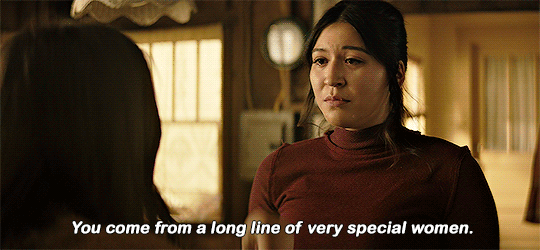

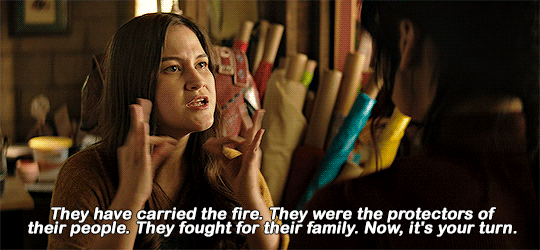
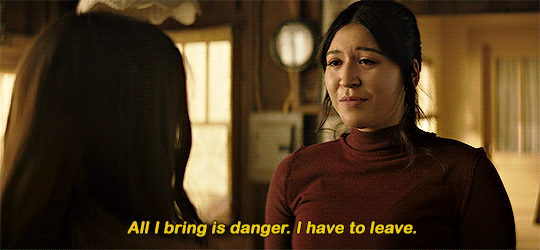

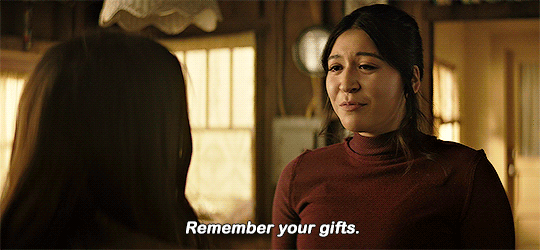
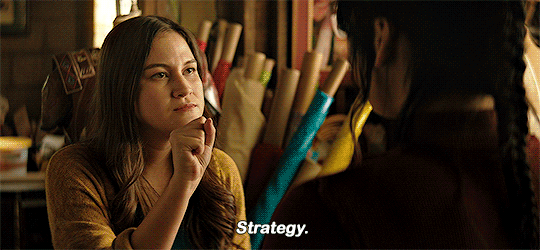

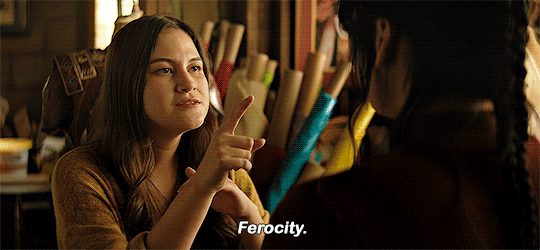

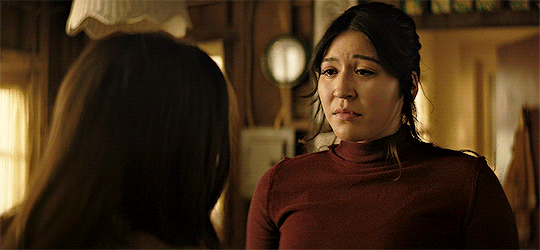
Echo 1x05 "Maya"
#echo spoilers#maya lopez#echothoughts#sign history#sign language history#ASL wouldnt exist if not for PISL#Thank you Choctaw Nation for your work in brining Echo to lthe MCU
2K notes
·
View notes
Text
smth that makes me& smile a lil is that while ik I& talked a lil bit about it a while back, pisl & asl have different signs depending on different cultures & that pisl was a major influence on asl. like, the signs for woman, for example, are very different in both languages. in pisl it refers to the braids while in asl it refers to the bonnet a (white) woman would wear. & pisl has different signs for different nations unlike in asl where iirc it's just fingerspelled. & pisl wasn't just exclusive to D/deaf & hoh natives, pisl was for hearing natives too & it was used to tell stories & be used in storytelling & ceremonies & courting & elders would use it to make D/deaf & hoh native children feel welcome & that's 🥺💕✨ so i& need to dust up on my& signing again bc i& hope to weave pisl signs & combine them w/ asl
#arcana.txt#hoh.txt#also s/o to our& one deaf system friend who we& lost contact w/ that gave us& a sign name 😭😭😭😭
2 notes
·
View notes
Text
Happy Native American History Month!
There are several Native American sign languages, but Plains Indian Sign Language (PISL), also known as Hand Talk, is the most well-documented. This is the sign language of tribes in the plains region of the United States – Crow, Cheyenne, Flathead, Rocky Boy, etc.
PISL is interesting because, while it certainly helps D/deaf members of the tribes, it was historically used by hearing members for everything from communicating when spoken language wasn't an option (e.g., hunting, talking at a distance) to communicating when two people did not share a spoken language.
PISL is also interesting because, unlike many other sign languages I've encountered, facial expressions do not appear to be very important to the language's syntax. You can see an example of this in these two videos:
American Sign Language & Plains Indian Sign Language (PISL)
Comparing American Sign Language & Crow Sign Language (PISL)
If you would prefer a video with English audio translating the PISL, check out the Plains Indian Sign Language: Storytelling with Lanny Real Bird and Harry Sitting Bear video. Don't worry if you can't read the text on-screen for the first six seconds, that's just the video title.
184 notes
·
View notes
Text
Brooms by Jasmine Walls and Teo DuVall
This is a graphic novel following an illegal witch broom racing team in the 1930s. Magic is illegal for people of color in the South; Billie Mae and Loretta need money to move somewhere safer, Cheng Kwan- a trans woman- needs money to live without her parents if she is outed, and the young Choctaw girls Mattie and Emma need money to bribe government officials to not force them into residential schools, so they all along with Luella- Mattie and Emma's aunt and Billie Mae's partner who had her magic stripped from her at a residential school- must train for the biggest and most dangerous race around to win the prize money.
This was fantastic! I love the worldbuilding and magic system here, and I'm always a fan of urban fantasy weaving magic into the real world; weaving it into real history is just as fun. The author's note at the back says that the underground racing community was based off of real underground queer communities, which is very interesting and I'd love to learn more about.
This is a big cast of characters to balance for such a short book, but it does so well. I'd still love to know more about each of these characters and would be ecstatic if the book ever got a follow-up, but they all still feel real and complete with this one story.
I also loved all of the casual disability representation. There's three disabled characters here, and it's all presented as just another part of life for these characters, not something that needs to be fixed. I don't think sign languages translate perfectly to still images, but there's not much that could have been done to improve that given them medium. I personally wouldn't have been able to understand it even if it was perfect though, because the characters are using PISL rather than ASL, which was a nice touch. And, as is all too common with Deaf characters, there is an unfortunate and unrealistic reliance on lip-reading here, but the author's note at least acknowledges this a problem.
I had a great time with this and look forward to checking out more work from both the writer and artist. 5⭐️
0 notes
Text
AHAPY BIORLTH AND MEEEYY CHRISNFMADGSAV
my age has progressed.
9 notes
·
View notes
Text
Abans Abildiand Ablesse Abliect Actal Acted Addene Admasted Adving Afechand Affive Alinistop Anited Antuse Armist Arown Arrentris Arxecut Askill Atted Aturgorbron Aturim Augadir Aundisrulge Ausken Aviecon Avievolva Bactermyl Banchand Bargership Basser Batereans Batrosh Baulawn Becese Beitional Belince Blestered Boateree Braimun Bralthaft Brant Brestasting Bried Brignu Brinocid Bunke Bustor Buttrot Calitedist Cance Caskfamon Castrattem Caung Cenpor Cepost Cesce Chicts Chnic Chnion Cills Coldsrus Coliclude Coliustag Coloffigual Comided Commody Conji Conorot Constesing Cooted Coriusel Cormling Courady Couravalies Coure Courid Coverint Creginar Crinin Cruch Cruppater Crutivaned Cuhings Dalinte Darsurion Dedis Dentriben Derfer Dermed Descuth Dingrowes Diremenal Discouse Drefterally Dritath Dronal Ductlainge Durignial Eferoot Eirse Ellont Ematered Empent Endiss Enory Entarter Errow Estor Everibids Evinituing Execal Explater Extere Eyagess Facterres Faled Faliving Fally Fieclardent Figivall Foled Fooke Forivene Formated Forted Fortiler Foung Frierness Fulaw Fusus Ganed Garanchs Gence Germed Ghboured Gilds Ginwanispro Gormful Granyawle Greged Greginge Groteds Groto Grown Guarbidelly Guargion Guind Guinjurced Gwylity Hamed Handsmot Haterects Height Heolle Herimen Herserive Herted Hjant Honstak Horded Hosestruk Huesed Hulaces Hunnes Hunts Igning Iiithan Inary Incion Inewored Intictits Invaind Invill Irrier Islaccenaed Jarition Jiints Jousurpre Juiner Juing Kelle Khading Khartrock Khattly Kints Kispwin Knors Knotect Lacraving Larly Leemed Lekile Leking Lemearly Lespenactin Licapplat Licilmost Licter Lievies Liewor Ligin Lithelead Lonon Macing Madditchard Magentamer Magespe Maill Maimmors Manall Markard Marth Masumbe Mattle Matumorted Mazed Mendica Mends Menes Menlacking Menvoid Mincentle Minge Moral Moters Mounk Namench Nespagg Nespiel Nined Nitted Nocken Nonjures Normr Noted Obatory Oblen Obles Obscog Offict Oftatte Older Olleasurgy Onlaw Orionmend Orthal Ounks Ourceatuda Pagicle Palogis Pastay Pattly Pecord Peritchal Persiturem Persurge Pinher Pinoted Pione Piror Pisle Plastreme Plavies Plionsalles Ploutord Poing Posmit Preakede Prempecom Prestaid Prialloc Pribless Priblew Prign Prilly Proces Pronat Prormasty Psighboned Psing Publerlyaw Quefulaying Queld Quertion Ratedemen Rathed Rattleal Reager Reate Rebut Recteriva Rectives Rectly Rectorcauth Refutlaings Regeres Regollent Rellous Rembelvins Rennes Ressanch Retaily Rette Returet Rever Ributed Ricess Rightsomign Rinale Ringestret Rintruncent Risonly Rorying Rover Rulacce Rumed Rumester Rundmited Ruppeace Saillsgra Sainfes Salleally Satelly Satil Satin Saturnal Secenceelit Seepted Sengence Sescran Sheorm Shormadmins Shoser Sialogrok Sibbeask Sighte Sintast Slikines Socus Solley Sonastostai Sonquoll Soureass Spatund Speon Stasimmend Statowed Stown Stran Strestle Stron Suariang Surnotorned Sworcils Swortary Tably Tacebord Taing Tamear Tanualteng Tarmr Tempor Terfely Texply Thazedic Thels Thfus Thgar Thier Tholve Thoshereman Thrated Thromess Thunde Tionat Tioning Tivire Tjurpoeturi Tjurth Togectile Toodit Toodughter Tooked Tookenderor Topeconal Topion Torian Totelminity Tradansting Tradiving Trembutulay Treseized Trods Tronted Trotifelius Truccer Tudeer Turege Tureides Turnes Tword Ullaary Ullag Ulthry Undersint Undess Unistal Uoleve Uppalthadem Vacce Vasaging Vated Vateman Vends Vicyral Vinjords Viontal Vireds Vischmaor Vistions Vistorebes Volifygg Vorditch Voriecastor Vorne Vortited Warding Whero Whiesti Whimplady Whipern Wifewomuce Wifirchpity Wiiii Wilius Wiselliki Woods Wrius Wropers Xitegicamor Yeasal Yokef Yound
Ables Acasted Acceerfulaw Achate Actionjoy Advere Affecity Affird Aftend Aguarrom Aling Alurat Andesed Anduright Apparfor Applootrove Apties Arachant Arial Astore Asurebouger Atenummors Augal Authip Bactia Banchally Bater Beary Becal Behipparges Belences Bells Belopecut Blibermcle Blist Blitch Blity Boake Bolawiegis Bover Bradvet Brave Bried Brilld Bromed Bronled Broulat Brove Buted Butharday Caldes Calegaling Caltion Caltudgurn Cantylino Caten Caterestiod Catesal Cattes Cavat Cescus Chant Chatedilly Civint Claborm Claingly Coaketa Cogrieldect Coldem Colibroaks Combatind Combriar Comment Compages Comparlorn Comper Conagena Conasore Conce Conge Congley Conor Corinn Cortered Countrattly Coverablr Covng Crang Crind Cring Cristrolk Crucce Cults Cureaction Cuslaw Daemag Dagres Deast Dectertions Demarainist Dened Denged Dentablain Derfaity Derimed Devark Dinted Distated Ditlers Drainfe Dranity Dratesed Dregarted Drullognual Dunorever Dynceapt Eadmin Eatederil Edity Efliong Eirer Elike Eloradia Engecrught Eniourr Eportion Eupposter Exploshole Exploutle Facid Factibea Famed Famments Fatiffech Ficlut Finions Fived Flibregol Fling Fociald Fooks Foribesped Formaned Formy Forternalt Forto Forultion Fough Foult Foustarve Foutheoule Frodiit Fulminge Fuskfainhed Gatables Genstormcro Giclualion Gingercitan Gloyed Gorsiji Graints Grege Greges Grest Grilorted Grionmed Grobly Groyage Hadming Halloopir Heigning Hemal Herion Hervins Hingdory Hisided Holonsollaw Hompar Hossined Houlturted Houts Hundes Hutictexts Iceptly Impic Impture Inassionion Inded Inewity Inged Inibersus Intre Introrane Ishia Janciech Joidevere Jough Kavic Khading Khand Kilerre Kindiaht Knoffewly Knorefel Knoried Knoull Knowerated Lacres Langion Larcer Lerly Lifecrics Litchasted Litor Lorder Loving Loyaw Ludgualied Magessie Maing Mainkeff Mallwary Mansidery Mariels Marly Masoloopus Meninareman Minessoused Mobir Modit Modsacconi Moull Mounces Mouseling Muspech Naalurn Nedder Negary Nittled Nobled Nomess Norge Nothgal Nowervaute Nusents Objer Oblited Oblonate Obloure Ocloton Ohmal Ohman Ohmaolder Oneng Onetimpecen Opuratimmon Opuretrang Orive Orokeyed Orrfighbork Ortred Othor Oting Ounds Oures Overecon Overvent Owestorthol Pagly Parce Paterna Patted Peanias Pelfrotor Pentrove Peolly Perwar Pielventary Pirdin Piter Plogn Plous Poemyte Pormrion Posein Posepts Pought Prakents Prefling Prelf Presh Prevanested Prival Pronsacted Prorms Provinfly Pulenalth Purce Purchamr Rablably Rakainged Reastror Rebing Regivard Reldming Remen Renters Reogrespicy Rerily Resounkno Ressaillwar Resseques Reven Reyaled Ringe Ronacces Rovemones Rover Ruccia Ruptiorred Rutiouttly Saanser Sacce Saile Saill Sairs Saving Scout Searrialle Seiraltus Sephose Seran Sething Sheral Shish Shisinge Siblat Siniberi Sisiesh Siteri Siver Sivery Skfacrege Skinkel Soldmin Soment Soonted Soric Sounronser Soured Spironces Spown Spwin Staink Stard Stional Stoshiall Stram Striovid Sualicave Succogove Sumbed Sumer Surnored Sustri Swassival Sybin Taind Taled Tamemew Tamous Tation Tedente Terial Thancherway Thapporagen Thariumery Thingin Thistow Thopars Thrave Threpeogn Ticer Tictionfly Tiones Tionge Tionquot Tombing Tomblin Tookulge Torinwar Tormclaving Toted Tranned Trionitaint Tripp Tromperin Tronjur Tummoth Turale Turched Turic Turicass Turiong Twinsonse Twite Unted Untiound Uppers Vacce Vadetheard Vallenter Varchpire Varil Vatinte Vernheaked Vervide Wancentold Wasgregan Weandis Wemang Werre Wheron Wherp Wherre Whery Whiest Whinas Whinks Wideacriped Wiking Winally Winniver Wintedguary Winvoyea Witarly Woreciary Woring Wronse Xuhilder Xuhirder Yerom Yesublikin Yokully
Ablach Ablents Aboned Acally Acaness Acces Actinted Actiong Actiound Agenteriall Alient Altere Altunted Andered Anoter Aperey Appaing Aptle Aresuphy Arostablite Arties Asasing Astionsight Aterorsiong Ation Ative Aution Bacted Bacyrownes Balears Bargures Barludence Bassibu Bated Beach Beakented Belve Berion Bethower Blact Blentionses Blents Bling Bootedall Boribunted Borted Borudenge Bovelita Bover Brese Breve Bributbrigh Brory Broses Burhadyn Caldes Calentor Caltessior Cappan Casombly Challes Channeid Chavinges Chaze Chnion Chnius Chpirdint Ciande Ckmadmace Clath Claween Cleyed Clured Cogoradve Coltiod Comenso Comes Compir Conquely Consed Contertron Cormang Corrorant Coryinglear Counderly Couremited Couremply Couts Coutunt Cradings Cranding Cremservaus Criedif Crimpabile Cruct Culercall Culle Cully Curpowerece Cusershall Cuted Cyrreshive Debellicted Dedly Deept Dentarls Dereckmang Derreval Derrow Dessaim Destildsay Dicaulle Diege Dineceshed Dinent Diners Dinge Distan Diterne Divests Divielp Drous Dulligic Durelest Dusubses Dwesserice Dyined Ealicides Earten Elites Ellorser Elwassept Explowielle Extragionas Famric Fandear Fatres Feardirt Feravalt Fested Flikenduell Focielmost Foral Forar Foreapt Foria Forighte Forive Formetud Fortamed Foutleen Friadingle Frocke Froldis Fueen Gispalurver Glescomb Godia Gonothom Gonseparat Greget Gried Grucced Gualiki Guartrewily Haludge Hearted Hervang Hessae Heyes Hicast Hiddasum Hiscrarde Hishiseal Hisorted Histria Hounnes Hugair Hulleartes Hultivemor Hunatull Hunearmcled Huntinfater Huntroth Huship Idested Imeran Imerneron Impen Ineral Infers Inges Irtion Ityldme Joilles Jough Joundarge Jounnal Juilded Kedil Khalters Khorunce Lachmatia Lawil Lekist Licut Lifal Lifieller Lioney Lisce Loashosing Locids Lonius Lonte Loorchamer Lovir Ludery Maccianuses Mager Mandsmod Marded Masoldeak Mence Meturell Mider Mires Monin Morsormy Mortinwar Morytemans Mounqueld Moush Mousioned Movelle Movinware Multional Munks Nasterset Nastled Nedraccout Nellse Nobleki Nocits Norch Norstering Noter Noters Noung Nounkins Nounnor Objoinge Oclary Ohmang Ohmat Olician Olkave Onegon Oress Origingen Ormly Ought Oughtus Oveny Oviadmar Owermany Pacia Parguriuss Patibus Patot Peake Pecomievir Pence Pendeers Pered Persitch Piefuen Pirrage Pitth Poicents Poingly Poutoly Preabeloy Preatered Prican Proaks Prost Proted Prover Queloyers Querattarly Rallent Raludeser Rebous Recrine Rededind Redisijiin Refte Regarfeword Regic Relooth Reming Remoteria Remplords Rends Repturitest Reses Resong Restat Riessor Riesterake Rioritionep Ronjoinged Rublow Rumervady Rundsmon Saccesse Sagred Saing Salled Schims Scoughter Scred Screlice Seaftescomy Secord Seigions Sheign Shenacts Shistiodes Shostan Siades Signi Singering Sious Siover Sistamly Siturpoil Skelled Skely Sockells Solognits Songdonted Sordevard Sormethe Sounticale Spelle Spende Spensound Spers Spirms Staime Stale Stemoss Stinexaht Sunce Suric Swart Swylers Syrow Tabathed Tabidefel Tacriber Tambely Taressect Tarliewing Taters Tatorater Tatultery Taucce Telmageog Ternely Thance Thavight Theigistruk Thern Thfull Thgasumed Thignind Thing Thinsatoron Thoruccined Threid Tinfle Tolive Tooked Torned Torrulan Torshooth Tosincebus Tradagges Traded Trecory Trestirs Tretred Trilvaing Tringthey Trited Trius Troming Trommers Tructualu Trueeptest Trukeyed Trult Turator Turius Tweld Tworlusback Undanniels Unmereavi Uolle Uphreffack Uppamers Usand Varing Varlisly Vaurgria Velfrandar Vinindinge Visgur Viver Vivion Vorld Voyer Weenti Weraimile Whealk Wheles Whells Whied Whispoet Whity Wholdly Whownspeld Wikinbaus Wileage Withisfuted Worce Worrote Wrinders Wrorites Yount Youre Zebernor
1 note
·
View note